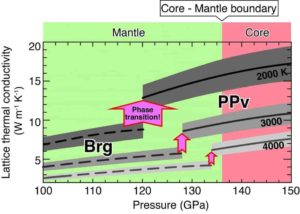
Lattice thermal conductivities of MgSiO3 bridgmanite and postperovskite (PPv) phases under the Earth’s deepest mantle conditions have been determined by quantum mechanical computer simulations. Researchers at Ehime University found a substantial increase in the conductivity associated with the phase change. This indicates that the PPv phase boundary is the boundary not only of the mineralogy but also the thermal conductivity. The effect of anisotropy on the conductivity of PPv in the heat transport properties at the lowermost mantle was also found to be minor.
Heat transport in the deep Earth controls its thermal evolution. Determination of the thermal conductivity of the lower mantle is one of the central issues for a better understanding of deep Earth phenomena, such as the style of mantle convection, the evolution of the magnetic field, and inner core growth. However, it is poorly understood because deep mantle pressure and temperature conditions are quite difficult to replicate in laboratory experiments. In the new study, the researchers determined the thermal conductivity of MgSiO3 postperovskite, the most abundant mineral at the bottom of the mantle, which is transformed from MgSiO3 bridgmanite,under the lowermost mantle conditions based on quantum mechanical computations without any empirical parameters.
The scientists found a jump in the thermal conductivity associated with the phase transition, indicating that the postperovskite phase boundary is the boundary not only of the mineralogy but also the thermal conductivity (Figure 1). The phase change produces larger lateral variation in heat flux across the core-mantle boundary (CMB). Also, they examined the effects of anisotropy on the thermal conductivity of the CMB heat flux and found that it to be minor with the crystal orientation of postperovskite. This may explain how seismic anisotropy observed at the base of the mantle is developed.
Reference:
Haruhiko Dekura et al. Lattice Thermal Conductivity of MgSiO 3 Postperovskite Under the Lowermost Mantle Conditions From Ab Initio Anharmonic Lattice Dynamics, Geophysical Research Letters (2019). DOI: 10.1029/2019GL085273
Note: The above post is reprinted from materials provided by Ehime University.










